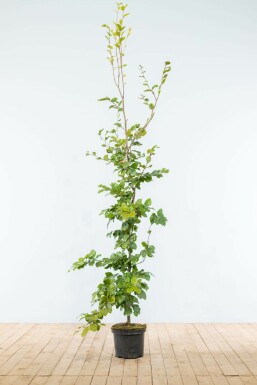


40-60

6
Welcome the majestic Fagus sylvatica, more commonly referred to as the common beech or European beech, into your landscape for an essence of stately European woodlands. This venerable species, native from Europe to the Caucasus, is renowned for its smooth, gray bark and lush, green foliage that transforms into a striking copper hue in the autumn. Although the beech does not flower, its dense, leafy canopy provides a serene backdrop or an elegant privacy screen, making it an impeccable choice for gardeners seeking a touch of arboreal nobility.




















































The European beech, or Fagus sylvatica, is a majestic addition to any landscape, offering a stately and lush presence. This deciduous tree, native to Europe and the Caucasus, is revered for its smooth, silver-gray bark and a grand canopy that presents a spectacle of changing colors through the seasons.
As a hedge, the common beech provides a dense and leafy barrier that morphs from vibrant green in spring and summer to a tapestry of brown and orange in autumn. Its ability to retain the dried leaves throughout winter until new foliage emerges adds to its appeal, providing an uninterrupted visual screen year-round.
Noteworthy attributes of Fagus sylvatica include:
When cultivating Fagus sylvatica, consider the following advice to ensure its healthy growth and development:
We would like to provide some tips on how to plant and care for a Fagus. By following these tips, you can be sure to enjoy your Fagus for a long time.
For successful cultivation, positioning this species in a location that offers a well-drained substrate is critical to ensure optimal growth and health. It thrives across a wide range of lighting conditions, from full sun to partial shade, and even in shaded areas, although the density and vibrancy of the foliage may be influenced by the amount of light received. The adaptability of Fagus sylvatica to various soil types makes it a versatile choice for different landscape designs, but attention should be given to soil quality to promote robust development.
To ensure successful establishment, Fagus sylvatica should be planted in well-drained soil, and although adaptable, the species thrives best in locations that offer full sun to partial shade. The ideal planting period for bare root specimens is during dormancy from late autumn to early spring. It is crucial to plant the hedge at the correct spacing to allow for its annual growth rate of 40-60 cm, facilitating a dense visual barrier. The robust nature of this species is underscored by its winter hardiness, capable of withstanding temperatures as low as -17.8°C, aligning with USDA zone 6.
For optimal health and shape, Fagus sylvatica should be pruned twice per year. The first pruning should occur in mid-June, after the initial spring growth has settled. The second pruning is best done before the end of August, to allow the plant to recover before entering dormancy. Despite its moderate growth rate, this species maintains a naturally dense habit, making extensive cutting unnecessary. Always ensure that tools are sharp and clean to promote quick healing and maintain the plant's vigor.
Fagus sylvatica, once established, displays moderate drought tolerance, though consistent moisture is important during its formative years to support a robust root system. During extended periods of dry weather, it is recommended to water deeply and infrequently to encourage the roots to extend deeper into the soil, which in turn enhances the tree's overall drought resilience. Young plants, in particular, benefit from regular watering until they are fully established. During the winter, the need for additional watering diminishes significantly, as the species is well-adapted to the cooler, moist conditions of its native range.
To maintain the health and vigor of a beech hedge, fertilizing is a crucial aspect of its care. Ideally, fertilization should occur in early spring before the new growth begins. A balanced fertilizer, rich in nitrogen, phosphorus, and potassium, is suitable for promoting lush foliage and a dense habit. Apply the fertilizer according to the manufacturer's instructions, ensuring even distribution at the base of the hedge. It's important not to over-fertilize, as this can lead to excessive growth, requiring more frequent pruning. A second application can be made in mid-summer to sustain the hedge's vitality, especially since it has a robust growth rate and appreciates nutrient replenishment to support its development through the growing season.
The Fagus sylvatica's smooth, silvery bark adds a striking visual element to any landscape throughout the year. Its dense canopy creates a lush, verdant dome in summer and turns to a spectacular display of copper tones in autumn. This species is known for its longevity, often maturing over several centuries, and thus serves as a heritage plant for future generations. The common beech's tolerance for heavy pruning makes it an excellent choice for hedges and topiaries.
Fagus sylvatica, commonly known as the European Beech, is the quintessential choice for those desiring a stately and classic addition to their landscape. This majestic species not only offers year-round visual interest with its smooth gray bark and lush foliage, but it also provides a regal sense of structure and elegance to any setting.
